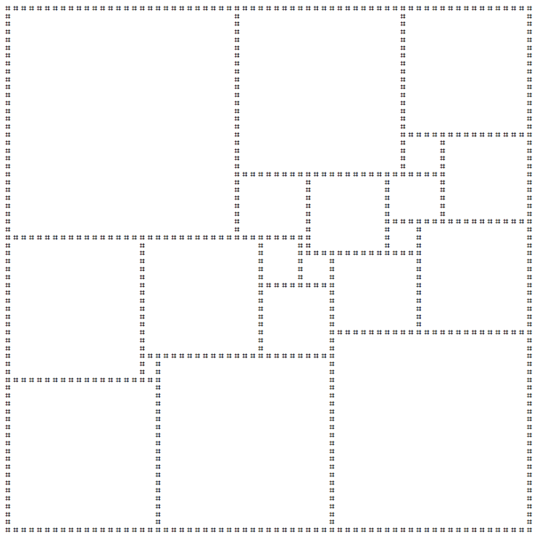16
Squaring the Square is a process of tiling a square using only other squares. If this tiling only uses squares of different sizes, then it is considered to be perfect. The smallest possible perfect squared square is a 112x112 square tiled using 21 different squares.
I have created the ascii art version of this square below:
################################################################################################################
# ## ## #
# ## ## #
# ## ## #
# ## ## #
# ## ## #
# ## ## #
# ## ## #
# ## ## #
# ## ## #
# ## ## #
# ## ## #
# ## ## #
# ## ## #
# ## ## #
# ## ## #
# ## ## #
# ## ## #
# ## ## #
# ## ## #
# ## ## #
# ## ## #
# ## ## #
# ## ## #
# ## ## #
# ## ## #
# ## ############################
# ## ############################
# ## ## ## #
# ## ## ## #
# ## ## ## #
# ## ## ## #
# ## ## ## #
# ## ## ## #
# ############################################# #
# ############################################# #
# ## ## ## ## #
# ## ## ## ## #
# ## ## ## ## #
# ## ## ## ## #
# ## ## ## ## #
# ## ## ## ## #
# ## ## ## ## #
# ## ## ## ## #
# ## ## ## ## #
# ## ## ###############################
# ## ## ###############################
# ## ## ## ## #
# ## ## ## ## #
################################################################## ## ## #
################################################################## ## ## #
# ## ## ########################### #
# ## ## ########################### #
# ## ## ## ## ## #
# ## ## ## ## ## #
# ## ## ## ## ## #
# ## ## ## ## ## #
# ## ## ## ## ## #
# ## ################## ## #
# ## ################## ## #
# ## ## ## ## #
# ## ## ## ## #
# ## ## ## ## #
# ## ## ## ## #
# ## ## ## ## #
# ## ## ## ## #
# ## ## ## ## #
# ## ## ## ## #
# ## ## ## ## #
# ## ## ###########################################
# ## ## ###########################################
# ## ## ## #
# ## ## ## #
# ## ## ## #
# ########################################### #
# ########################################### #
# ## ## ## #
# ## ## ## #
################################## ## #
################################## ## #
# ## ## #
# ## ## #
# ## ## #
# ## ## #
# ## ## #
# ## ## #
# ## ## #
# ## ## #
# ## ## #
# ## ## #
# ## ## #
# ## ## #
# ## ## #
# ## ## #
# ## ## #
# ## ## #
# ## ## #
# ## ## #
# ## ## #
# ## ## #
# ## ## #
# ## ## #
# ## ## #
# ## ## #
# ## ## #
# ## ## #
# ## ## #
# ## ## #
# ## ## #
# ## ## #
# ## ## #
################################################################################################################
Your submission should print out the above square. You may print a reflection and/or rotation of the above square if you wish. A trailing newline on the last line is allowed. This is a code-golf, so the smallest submission wins!


@Optimizer According to the question and Wikipedia, all the small squares have to be completely different sizes. – Level River St – 2015-07-05T20:43:58.973
Nathan, Is my submission in accordance with the rules? I used a uniform thickness for all lines. – DavidC – 2015-07-06T16:44:00.387
@DavidCarraher I have each side of the square outlined (so inner sides have multiple pound signs). Also, you need to use
#instead ofX– Nathan Merrill – 2015-07-06T18:05:26.7131Nathan, In the plane, edges are not borders. They are one dimensional line segments. Where two tiles abut, we should see a single line, not two. Otherwise, we are conveying the idea that there is a gap between the tiles. – DavidC – 2015-07-07T07:12:38.617
@DavidCarraher while that is true, I think it makes more sense to represent it in ascii this way. – Nathan Merrill – 2015-07-07T12:57:36.043